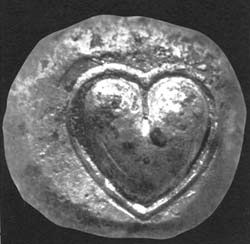The Original Seed Pod That May Have Inspired the Heart Shape
This historical botanical theory has its roots in ancient contraceptive practices.

The heart shape, with its rounded top and pointy end, is pretty innocent for a graphic: ❤️️ lacks the ribald connotations of a lipstick smack, or the peach emoji. But when using it to mean “I love you,” we may be calling back to something slightly more risqué: an ancient contraceptive.
Silphium, which once grew rampant in the ancient Greek city of Cyrene, in North Africa, was likely a type of giant fennel, with crunchy stalks and small clumps of yellow flowers. From its stem and roots, it emitted a pungent sap that Pliny the Elder called “among the most precious gifts presented to us by Nature.”
According to the numismatist T.V. Buttrey, exports of the plant and its resins made Cyrene the richest city on the continent at the time. It was so valuable, in fact, that Cyrenians began printing it on their money. Silver coins from the 6th century B.C. are imprinted with images of the plant’s stalk—a thick column with flowers on top and leaves sticking out—and its seed pods, which look pretty familiar:

So what was so great about silphium sap? According to Pliny, it was a kind of cure-all, used to treat everything from chills to fevers to corns. (Best of all, he wrote, “it is never productive of flatulency.”) Hippocrates said it could be used as a poultice, or to soothe the stomach. Cooks also used the plant in their recipes, perhaps the same way we use fennel seeds today.
It may also have been used as a type of birth control. “Anecdotal and medical evidence from classical antiquity tells us that the drug of choice for contraception was silphium,” writes the historian John Riddle in Eve’s Herbs: A History of Contraception and Abortion in the West. He points to the ancient physician Soranus, who suggested taking a dose of silphium “the size of a chick-pea” once a month, both to prevent conception and “destroy any already existing.”

In his Poem 7, Catullus wrote that he wants to share as many kisses with his beloved “as the number of Libyan sands that lie in silphium-bearing Cyrene.” It’s not too hard to imagine that he’s providing two prescriptions at once here: one for getting busy and one for preventing unintended consequences. Riddle also describes another, more explicit Cyrenian coin: “A seated woman has silphium at her feet, while one hand touches the plant and the other points to her reproductive area.”
Not everyone buys Riddle’s theory about silphium’s ancient use. In a 1994 New York Times article, other experts called it an “intriguing hypothesis” but went no further, saying there’s not quite enough evidence to crown the plant as a common form of ancient birth control. And even if we grant it that status, it’s still a bit of a leap from “heart-shaped seed of ancient contraceptive plant” to “enduring symbol of love.” There are also plenty of other theories about where the heart shape came from, ranging from a Catholic saint’s divine hallucinations to a bad organ description by Aristotle.
Today, ancient silphium is likely extinct, which bodes poorly for everyone who may have pledged eternal love via the shape of its seed pod. But there’s another plant that was probably used for contraception: the wild carrot, which is still around. If you want to show your Valentine truly undying love, consider drawing a different vegetable this year.























Follow us on Twitter to get the latest on the world's hidden wonders.
Like us on Facebook to get the latest on the world's hidden wonders.
Follow us on Twitter Like us on Facebook